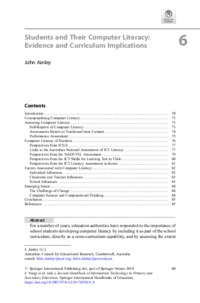Students and Their Computer LiteracyEvidence and Curriculum Implications
Zu finden in: Second Handbook of Information Technology in Primary and Secondary Education (Seite 69 bis 88), 2018
  |
 |
 Diese Seite wurde seit 1 Jahr inhaltlich nicht mehr aktualisiert.
Unter Umständen ist sie nicht mehr aktuell.
Diese Seite wurde seit 1 Jahr inhaltlich nicht mehr aktualisiert.
Unter Umständen ist sie nicht mehr aktuell.
 Zusammenfassungen
Zusammenfassungen
 For a number of years, education authorities have responded to the importance of school students developing computer literacy by including it as part of the school curriculum, directly as a cross-curriculum capability, and by assessing the extent to which students are computer literate. Computer literacy and related concepts, such as ICT literacy, are defined so as to include both technological expertise and information literacy. Assessments of computer literacy, even though they vary, indicate that there are substantial variations in levels of computer literacy among students in the lower years of secondary school. In technologically developed countries, approximately one half of Year 8 students demonstrate proficiency, or advanced proficiency, in computer literacy, but up to 10% have very limited computer literacy. Assessments of computer literacy can also provide the basis for progression maps that could be used to inform curriculum development. Those progression maps will be more valuable if the frameworks on which they are based become more strongly integrated with each other. In addition, computer literacy appears to be influenced by student background, including familiarity with computers, as well as the emphases placed on it in classrooms and schools and the support provided by ICT in education systems. At present, there is less information about school and classroom influences on computer literacy than there is about student background influences. In the immediate future, the construct of computer literacy may need to accommodate increasingly to changes in software and hardware contexts in which it is manifested.
For a number of years, education authorities have responded to the importance of school students developing computer literacy by including it as part of the school curriculum, directly as a cross-curriculum capability, and by assessing the extent to which students are computer literate. Computer literacy and related concepts, such as ICT literacy, are defined so as to include both technological expertise and information literacy. Assessments of computer literacy, even though they vary, indicate that there are substantial variations in levels of computer literacy among students in the lower years of secondary school. In technologically developed countries, approximately one half of Year 8 students demonstrate proficiency, or advanced proficiency, in computer literacy, but up to 10% have very limited computer literacy. Assessments of computer literacy can also provide the basis for progression maps that could be used to inform curriculum development. Those progression maps will be more valuable if the frameworks on which they are based become more strongly integrated with each other. In addition, computer literacy appears to be influenced by student background, including familiarity with computers, as well as the emphases placed on it in classrooms and schools and the support provided by ICT in education systems. At present, there is less information about school and classroom influences on computer literacy than there is about student background influences. In the immediate future, the construct of computer literacy may need to accommodate increasingly to changes in software and hardware contexts in which it is manifested. Dieses Kapitel erwähnt ...
Dieses Kapitel erwähnt ...
 Personen KB IB clear | Sara Dexter , Anusca Ferrari , Marc Prensky , Juliet Sizmur , Linda Sturman | ||||||||||||||||||||||||||||||||||||
 Begriffe KB IB clear | computer literacycomputer literacy
, DigComp
, ICT literacyICT literacy
, Informationskompetenzinformation literacy
,  turtle graphics turtle graphics
| ||||||||||||||||||||||||||||||||||||
 Bücher |
| ||||||||||||||||||||||||||||||||||||
 Texte |
|
 Dieses Kapitel erwähnt vermutlich nicht ...
Dieses Kapitel erwähnt vermutlich nicht ... 
 Nicht erwähnte Begriffe | DigComp 2.0 |
 Zitationsgraph
Zitationsgraph
 Zitationsgraph (Beta-Test mit vis.js)
Zitationsgraph (Beta-Test mit vis.js)
 1 Erwähnungen
1 Erwähnungen 
- Digitale Bildung im Grundschulalter - Grundsatzfragen zum Primat des Pädagogischen (Mareike Thumel, Rudolf Kammerl, Thomas Irion) (2020)

- Digitale Grundbildung in der Grundschule - Grundlegende Bildung in der digital geprägten und gestaltbaren, mediatisierten Welt (Thomas Irion)

- Digitale Grundbildung in der Grundschule - Grundlegende Bildung in der digital geprägten und gestaltbaren, mediatisierten Welt (Thomas Irion)
 Anderswo finden
Anderswo finden
 Volltext dieses Dokuments
Volltext dieses Dokuments
 |  Students and Their Computer Literacy: Evidence and Curriculum Implications: Artikel als Volltext bei Springerlink ( Students and Their Computer Literacy: Evidence and Curriculum Implications: Artikel als Volltext bei Springerlink ( : :  , 310 kByte; , 310 kByte;  : :  ) ) |
 Anderswo suchen
Anderswo suchen 
 Beat und dieses Kapitel
Beat und dieses Kapitel
Beat hat Dieses Kapitel während seiner Zeit am Institut für Medien und Schule (IMS) ins Biblionetz aufgenommen. Beat besitzt kein physisches, aber ein digitales Exemplar. Eine digitale Version ist auf dem Internet verfügbar (s.o.). Es gibt bisher nur wenige Objekte im Biblionetz, die dieses Werk zitieren.















 Biblionetz-History
Biblionetz-History